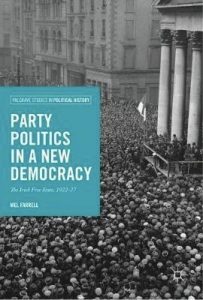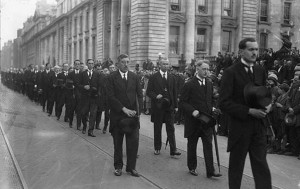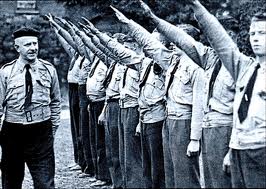Book Review: Party Politics in a New Democracy: The Irish Free State, 1922-37
 By Mel Farrell. Pp xiv, 332,
By Mel Farrell. Pp xiv, 332,
Published by Palgrave Macmillan. 2017.
illus. Cham, Switzerland & London;€93.59.
Reviewer: Timothy Ellis
A good ‘survey’ text is a vital possession for any serious historian who wishes to specialise in a particular region and/or subject in a specific period.
Historians have long lacked a detailed overview the political history of the Irish Free State (which lasted roughly from 1922-37). David Fitzpatrick’s The two Irelands, 1912-39 does explore this period, but only as part of a broader study, which encompasses the Irish Revolution and the experience of Northern Ireland. [1.]
John Regan’s The Irish Counter Revolution, whilst an accomplished, scholarly account of Free State politics sets out to explore the dynamics of ‘Treatyite’ politics: through Cumman na nGaedheal, the Blueshirts and Fine Gael. [2.] Until now, we have not been blessed with a solid overview which comprehensively explores the political parties, politicians and ideologies of the Free State.
Mel Farrell suggests in this study that the success of Irish democracy constituted a ‘joint enterprise involving constitutional figures, on both sides of the Civil War divide
Mel Farrell, however, provides us with such an overview. Rather than framing Free State party politics as irrevocably divided between ‘Treatyites’ and ‘non-Treatyites’, Farrell instead suggests that the success of Irish democracy constituted a ‘joint enterprise involving constitutional figures, on both sides of the Civil War divide.’ [3.]
The narrative proceeds logically and each chapter discusses a key flashpoint in the consolidation of the Irish democracy: the events leading up to and following the signing of the 1921 Anglo-Irish Treaty, Cumann na nGaedheal’s early achievements in government between 1923-6, the 1927 elections, the last years of Cumann na nGaedheal in government between 1927-32 and the impact of the Great Depression, the 1932 election, and the challenges to democracy in the 1930s.
The book opens with an extensive and useful summary of the historiography of the Irish Free State. This first chapter should be compulsory introductory reading for any students keen to deepen their understanding of the politics of Interwar Ireland.
Farrell criticises undue focus on individual political parties and the persistent of a cliched and flawed notion of ‘Civil War politics’.
Here Farrell clearly highlights the limitations of historians’ work on this period: namely undue focus on individual political parties at the expense of a bigger picture which is conscious of connections between parties and individuals. He also critiques the persistence of the clichéd (and rather flawed) notion of Civil War politics, in particular, critiquing Tom Garvin’s work on the Treaty for overemphasising the democratic credentials of the Treatyites and denigrating the republicans for alleged anti-democratic tendencies. [4].
Allegiance to different political parties was fluid, and interestingly, several figures switched from supporting Cumann na nGaedheal to Fianna Fáil.
Farrell argues, that developments over the course of 1922-37, rather than 1922-3 alone, shaped the character of modern Irish politics. Farrell also seeks to offer a fully contextualised account of this transformative period, looking ‘beyond domestic issues such as the Treaty, and frustrated nationalism,’ and exploring the impact of wider macro-economic issues, namely the Great Depression. [5.]
The second chapter offers a whistle-stop tour of the events of the Irish Revolution, starting in the 1890s, and working right up to the Anglo-Irish Treaty, and its aftermath. The discussion of the Treaty debates is nuanced and complex, with one of the key points being that the Treaty split ‘cut across the distinctions between purists and pragmatists, or politicians and soldiers.’ [6.]
Farrell argues that since no single, coherent ideology lay behind the Treaty, it could not easily form the basis for subsequent coherent ideological divisions
Farrell argues that since no single, coherent ideology lay behind the Treaty, it could not easily form the basis for subsequent coherent ideological divisions in the period 1923-37.

The third chapter begins by setting the Civil War firmly in a European context. Here, Farrell skilfully highlights similarities between this disruptive period in Irish history, and contemporary examples in Finland, Russia, Italy, Spain and Germany. Farrell then traces the establishment of the organs of the Free State and Treatyite political institutions.
We hear, for instance how Cumann na Saoirse (the Treatyite offshoot of Cumann na mBan) was actually the first distinctly pro-Treaty political organisation to be formed. The discussion of the constitution of the Free State Constitution is excellent, and here Farrell, notes its points of similarity with other new European Constitutions drafted in the aftermath of the First World War.
Farrell sets the Irish Civil War in the context of other interwar conflicts.
Farrell also offers some illuminating discussion of the political parties that emerged during the period 1922-3, with full discussion of Cumann na nGaedheal, Sinn Fein, the Farmers’ Party and Labour Party. We hear, for instance, how Cumann na nGaedheal, in organisational terms, took inspiration from the British Liberal party.
We then hear about the 1923 election. Farrell’s discussion of elections is particularly detailed, and is a commendable feature of this book. We hear much about the electoral machinery and preparations of both parties- increasingly, we are left with a sense that democracy was not just rhetorical aspiration, but indeed an ongoing commitment in daily life.
Chapter 4 focusses on Cumann na nGaedheal’s aspirations for and achievements in government in the years 1923-6. This discussion encompasses several different themes: such as fiscal policy, foreign policy, law and order, and cultural nationalism. Farrell makes a particularly intriguing point about the social activities it offered party members. It would be interesting to hear more about this.
Farrell devotes the fifth chapter to charting the events of 1927. This signifies a key part of the book’s central argument- that the characteristics of Interwar Irish politics cannot solely be explained by the Civil War, other turning points also matter, in particular, the year which saw the assassination of Kevin O’Higgins, book-ended by two general elections.
In 1927 in which ‘military commanders, authoritarian demagogues and imitators of Mussolini increasingly came to the fore in the politics of Europe, 1927 was the year in which the Dáil finally became fully representative of the Free State electorate.’
Farrell reminds us that in this year ‘as military commanders, authoritarian demagogues and imitators of Mussolini increasingly came to the fore in the politics of Europe, 1927 was the year in which the Dáil finally became fully representative of the Free State electorate,’ as Fianna Fáil chose to enter Dáil Éireann. [7.] Keen to avoid ‘Civil War’ dichotomies, Farrell reminds us of the significance of the Farmers’ Party and the National League in this pivotal election.

The sixth chapter is particularly commendable, as it focuses on the years 1927-32, a period which has been particularly neglected by historians. Here, Farrell articulates many of his monograph’s key arguments.
The five years before 1932 were a crucial turning point in shaping Irish democracy because ‘the party system [that] had characterised Ireland’s politics during the twentieth century had its roots in the September 1927 election result, while the smooth transition of power in 1932 laid the basis for subsequent changes of government.’ [8.]
Farrell notes that, during this period, support for Cumann na nGaedheal and Fianna Fáil began to solidify into two distinct blocks, though not necessarily along the Treaty split, and ‘defections of figures such as Patrick Belton, James Geoghegan, Dan O’Rourke, Padraic Ó Máille and J.J. Walsh showed that it was becoming less relevant to the political divide between the two parties.’ [9.]
The party system [that] had characterised Ireland’s politics during the twentieth century had its roots in the September 1927 election result, while the smooth transition of power in 1932 laid the basis for subsequent changes of government.
Economics, not ‘Civil War politics’ takes centre stage here. The 1932 election is presented as a contest between two distinct economic philosophies, and Farrell argues, convincingly, that it was Fianna Fáil’s support for tariffs and protectionism that brought Cumann na nGaedheal closer to the ‘Blueshirts’ and National Centre Party, thus laying the groundwork for the formation of Fine Gael.
Fianna Fáil differed from its rivals in that it was ‘less interested in economic efficiency and more concerned with worker pay and conditions.’ [10.] Meanwhile, W. T. Cosgrave was described by John Maynard Keynes as a ‘nineteenth century liberal.’ [11.]
The 1932 election, in which Fianna Fail first came to power, is presented as a contest between two distinct economic philosophies.
This chapter, in focussing on economics, is well-contextualised. Few historians have fully considered the significance of the Great Depression for the Free State, but Farrell explores its impact fully, and moreover, he thinks about the Free State in comparative perspective. Whilst Cumann na nGaedheal’s laissez-fair policies worked well in the context of the 1920s, the international Great Depression made Fianna Fáil’s protectionism all the more respectable.
The following chapter explains what happened after 1932. The key strengths of this work remain consistent: extensive attention is devoted to what Fianna Fáil’s economic policies once in government, and this is fully outlined with reference to the wider circumstances of international trade. Farrell also cogently explains why Fascism (and other forms of dictatorship) were unsuccessful in Ireland.
The Blueshirts, for instance, were rather unusual in that ‘few [other] Fascist movements were concerned about the protection of free speech or the protection of an existing state.’ [12.] After their merger into Fine Gael, the new party retained little of the symbols of continental fascism. Furthermore, whilst Fascists and Nazis in Italy and Germany quickly co-opted traditional conservatives to their movement, in Ireland, the Blueshirts were effectively subsumed to the more constitutional remnants of Cumann na nGaedheal (along with the National Centre Party).
Although Fine Gael departed from Cumann na nGaedheal, in some respects, namely in its embrace of more interventionist economic positions, the remnants of the latter remained committed to liberal, democratic values, and moved decisively against O’Duffy’s drift to authoritarianism. In the same way, and, at the same time, de Valera’s Fianna Fáil distanced itself from its links to the IRA. Irish democracy, therefore, had to be fought for and consolidated in the 1930s.
The final chapter opens with a good, in-depth discussion of the 1937 Irish Constitution and its wider meanings, and then discusses two important questions: ‘What really is the difference between Fine Gael and Fianna Fáil?’ and ‘Why was Irish democracy uniquely successful?’ Farrell notes that despite the clichés of Civil War history Fine Gael and Fianna Fáil remain distinct parties up to the present day.
In 2016, both parties refused to form a coalition government following the Irish election. The reasons for the Fine Gael- Fianna Fáil gulf cannot be reduced simply to the Treaty split and the Civil War. Both Fine Gael and Fianna Fáil were formed several years after the Treaty split. The circumstances of their formation suggest that they cannot be merely reduced to their positions on the Treaty.
Fianna Fáil left Sinn Féin because it needed to do more than simply oppose the Treaty. Sean MacDermot and James Dillon of the National Centre Party saw merger with Cosgrave’s Cumann na nGaedheal as an opportunity to end Civil War bitterness. Moreover, there were serious economic differences between both parties.
One supported ‘commercialism, free trade, financial orthodoxy,’ the other, ‘self-sufficiency, protectionism, social reform.’ [13.] Subsequent similarities between the two parties are not merely reducible to the superficiality of differences. Consensus between political parties has been fairly normal in European politics, not least after the Second World War. Political ideologies and identities are often fluid, and most major European political parties have seen rightward and leftward turns.
Nor can the question of why Irish democracy was successful (perhaps uniquely so), be reduced to the Civil War. Irish democracy was not simply ‘born’ in 1922 (as Tom Garvin perhaps suggests). Rather, like Ireland’s political parties, democracy evolved and was consolidated over time.
This may be seen in the key turning points of the 1922 Free State Constitution, the 1924 Army Crisis, the General Elections of 1927 and 1932, Cosgrave’s and de Valera’s decisive movement against extremists in the mid-1930s and the 1937 Constitution.
Whilst in Europe, anti-democrats were more prominent, anti-democratic tendencies were largely marginal in Irish political culture. Constitutional leaders, on both sides, were able to contain them. The Free State inherited a strong political tradition of democracy, individual rights and liberal values from its predecessors in the O’Connellite movement, the Irish Parliamentary Party and Sinn Féin.
Farrell’s monograph is well-researched, and draws upon an impressive array of archival sources from (among others) the National Archives of Ireland, the National Library of Ireland and University College, Dublin. The monograph also engages pointedly with the wider historiography on this period of Irish history, and a particularly impressive feature of this text is its deep awareness of wider European trends and parallels.
It retains a strongly comparative framework, and this greatly enhances our understanding of the argument. This text originated as Dr. Farrell’s PhD thesis, which was supervised by Prof. Filipe Ribeiro de Meneses, at Maynooth University (who specialises in the history of modern Portugal). This supervision has clearly done this monograph good and Dr. Farrell demonstrates an intimate and detailed acquaintance with broader trends in Interwar Europe, a feature which enhances this research greatly.
The emphasis on wider socio-economic questions also strengthens this work considerably. John Regan’s work on the Irish Counter-Revolution adopts a predominately ‘high-political framework’ and focusses minutely on the key personalities in Cumann na nGaedheal. Rather than focussing solely Leinster House machinations, Farrell shows us ministers who had to combat the effects of the Great Depression, deal with oscillating agricultural prices for farmers and fight elections.
The detail on the elections of the period 1922-37 is commendable. Farrell engages effectively with sources from the Fianna Fáil, and Cumann na nGaedheal/Fine Gael party archives, and we emerge with a sense of how all the political parties (not just the main two) went about engaging with a wider voting public.
We hear, for instance, about how political parties used cutting edge forms of technology for electioneering purposes- such as loudspeakers at public meetings. Admittedly, some of the ground has already been broken here by Ciara Meehan’s work on Cumann na nGaedheal [14.], but, by bringing in other parties, Farrell still makes an important contribution to knowledge.
On the whole, then, this is an entertaining, well-researched and eminently readable piece of scholarship.
Nonetheless, although we hear how politicians sought to engage with a wider public, the wider public remains somewhat absent. The reader does not hear much about the rank-and-file members of political parties in the Free State, their contributions, perceptions and beliefs.
Whilst Farrell does makes some interesting points about the social activities offered to ordinary members of both Cumann na nGaedheal and the Blueshirts, it would be good to hear more about the ordinary citizen’s participation in the democratic culture and processes of the Irish state. What activities and duties might ordinary party members have engaged in?
What factors swayed individual allegiance? What impact did propaganda have on the ordinary voter? However, in Farrell’s defence, it is difficult to see what sources one might have used in this research. Since few now remain alive who would remember this period as adults, oral interviews may not be viable.
In explaining the endurance and strength of Irish democracy, in the final chapter the analysis notes the resilience of a democratic tradition stretching back to the 1820s. This argument has certainly been advanced before [15.] What would be interesting to hear, however, is the extent to which the political culture of the Free State incorporated hangovers and inheritances from previous eras of Irish history. How, for instance, did longer-standing Irish political traditions negotiate with the modernity of the Interwar politics?
On the whole, then, this is an entertaining, well-researched and eminently readable piece of scholarship. It engages incisively with a wider historiography, and therefore has much to interest the scholar.
Since it offers an accessible overview of a pivotal decade and a half in Irish politics, it therefore, also has much to attract the student and general reader of Irish history. With the close of the ‘decade of centenaries’ in 4-5 years, our attention will naturally turn to the politics of the Irish Free State. It may well be the case that this book spearheads a blossoming of interest and scholarship in this most fascinating phase in Ireland’s political development.
___________________________
Footnotes:
[1.] David Fitzpatrick, The two Irelands, 1912-39 (Oxford, 1998).
[2.] John Regan, The Irish counter revolution, 1921-36: Treatyite politics and settlement in independent Ireland (Dublin, 2001).
[3.] Mel Farrell, Party politics in a new democracy: The Irish Free State, 1922-37 (Basingstoke, 2017), p. 13.
[4.] Ibid, pp 9-10; Tom Garvin, 1922: The Birth of Irish Democracy
[5.] Farrell, Party politics in a new democracy, p. 14.
[6.] Ibid, p. 45.
[7.] Ibid, p. 151.
[8.] Ibid, p. 194.
[9.] Ibid, p. 195.
[10.] Ibid, p. 209.
[11.] Ibid, p. 224.
[12.] Ibid, p. 266.
[13.] Ibid, p. 294.
[14.] Ciara Meehan, The Cosgrave party: A History of Cumann na nGaedheal, 1923-33 (Dublin, 2010).
[15.] See, for instance, Bill Kissane, Explaining Irish democracy (Dublin, 2002), p. 16.